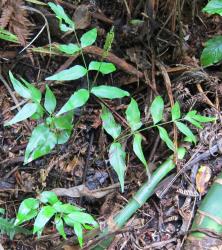Terrestrial or rupestral ferns. Rhizomes erect (NZ) or creeping (not NZ), bearing hairs (NZ) and sometimes non-clathrate scales (not NZ). Fronds hemidimorphic, with fertile and sterile pinnae markedly dimorphic (NZ) or occasionally monomorphic (not NZ), not articulated to rhizome. Stipes hairy (NZ) and occasionally scaly (not NZ). Laminae 1-pinnate to 4-pinnate, anadromous proximally and catadromous distally, herbaceous or coriaceous, hairy (NZ) and occasionally scaly (not NZ). Veins reticulate without free included veinlets (NZ), or free (not NZ). Sporangia limited to the basal pair of skeletonised pinnae, which are held erect on long stalks (NZ), or occasionally borne abaxially on unmodified laminae (not NZ); sporangia in two rows either side of a vein, not in sori, sessile, slightly asymmetrically ovoid or pear-shaped, with the annulus horizontal around the outward-pointing apex, dehiscing by a vertical longitudinal slit; spores maturing ± simultaneously; 32–256 spores per sporangium. Homosporous; spores trilete, with coarse echinate or bacculate ridges, or rarely reticulate, lacking chlorophyll.
A family of one genus and about 115 species (PPG 1 2016).
Earlier classifications have varied in their treatment of the Schizaeales. Allan (1961) and Kramer (1990) included the Lygodiaceae and Anemiaceae in the Schizaeaceae, whereas Pichi Sermolli (1977) maintained all three as separate families. Three families are now recognised within the Schizaeales (PPG 1 2016), with Anemiaceae sister to Schizaeaceae (Schuettpelz & Pryer 2007; Labiak et al. 2015).
From one to five genera have previously been circumscribed in Anemiaceae, but Anemia (including Mohria) is now generally accepted as the sole genus (Smith et al. 2006; Labiak et al. 2015; PPG 1 2016; Mickel 2016).
Anemiaceae is a family of terrestrial ferns with erect or creeping rhizomes, hemidimorphic or rarely monomorphic fronds bearing hairs and occasionally scales. The sporangia are usually borne on a basal pair of highly modified pinnae, or occasionally abaxially on unmodified laminae; they are not aggregated in sori, and each has a horizontally arranged subapical annulus. The spores are trilete and coarsely ridged.
A family distributed in America from Texas to Argentina, southern Africa, Madagascar and peninsular India (Kramer 1990), with the great majority of species in the Americas. One genus and species casual in New Zealand.
| Category | Number |
|---|---|
| Exotic: Casual | 1 |
| Total | 1 |




